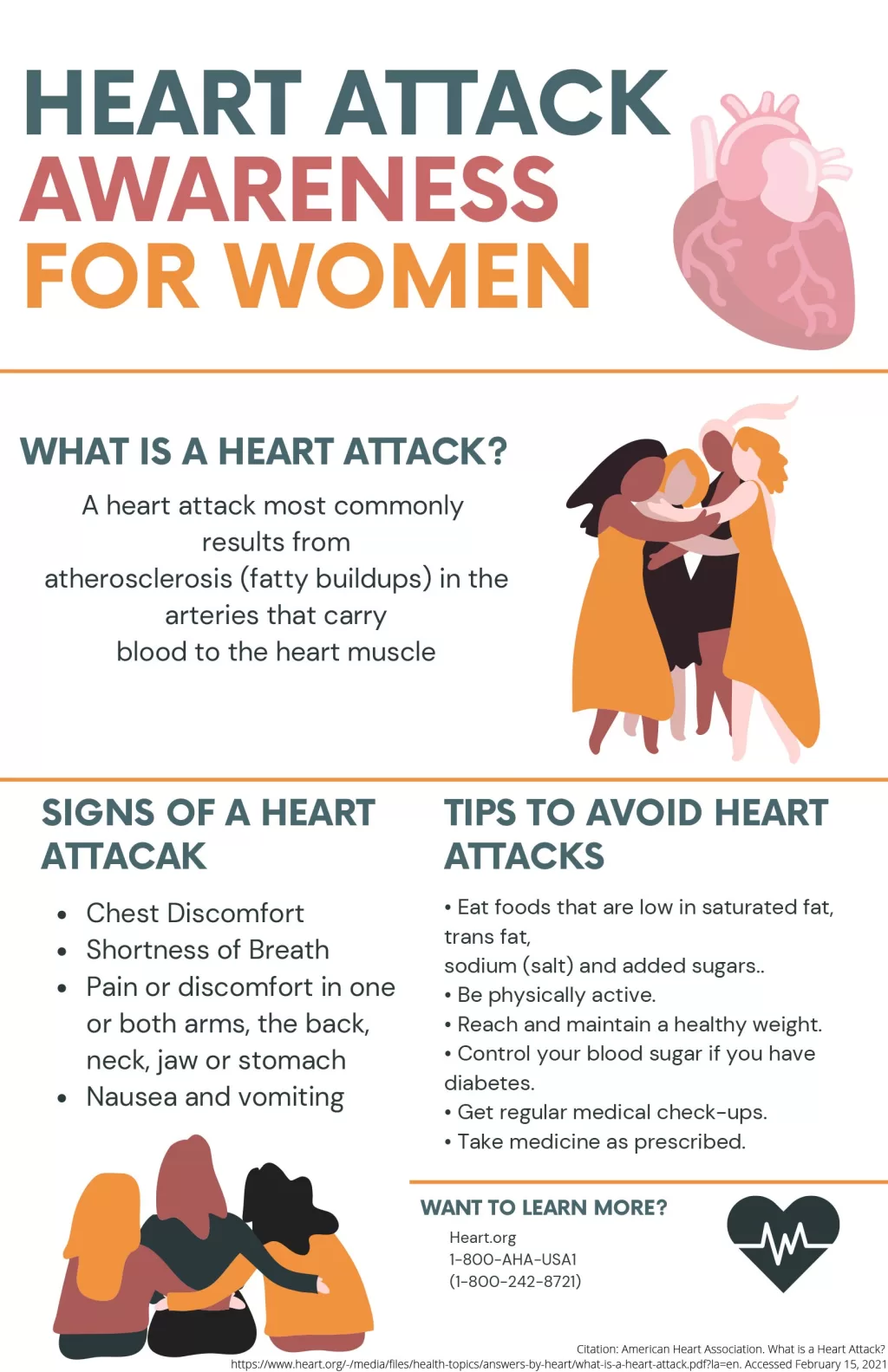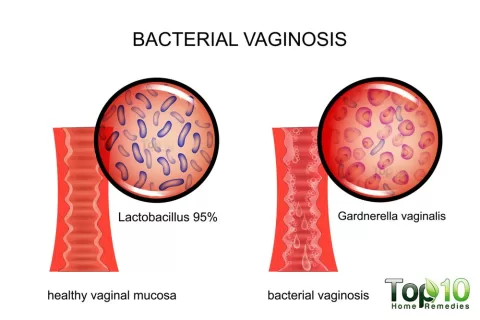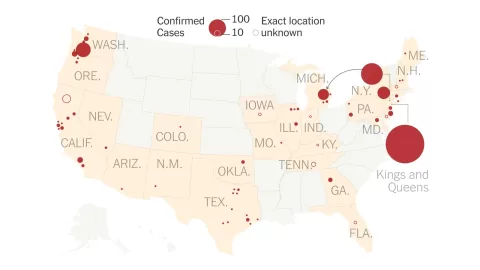Heart attack awareness for women is crucial, as many are unaware of the unique symptoms that can signal a heart emergency. Unlike their male counterparts who often experience classic indicators such as chest pain, women may face atypical heart attack symptoms like jaw pain, fatigue, or excessive sweating. This lack of recognition can lead to devastating consequences, as many women delay seeking help despite experiencing significant discomfort. Pamela Kays, a 56-year-old NICU nurse, found herself in that very situation, having been rushed to the emergency room after ignoring her body’s signals. Educating women about heart disease awareness is vital to improve their heart health and empower them to take action when faced with potential heart attack symptoms.
Understanding the signs of a heart attack is essential for everyone’s safety, particularly for women who may not always recognize the warning signals. The term “myocardial infarction” refers to the common medical terminology for what we colloquially call a heart attack, but it’s the often atypical symptoms that present a challenge for women. While traditional heart attack symptoms are well-known, lesser-known indicators can include overwhelming fatigue and subtle chest discomfort. These discrepancies underscore the importance of heart disease education tailored specifically to women, ensuring they are equipped to identify when to seek urgent medical care. By addressing these gaps in knowledge, we can significantly enhance women’s heart health outcomes and save lives.
Understanding Heart Attack Symptoms in Women
Heart attack symptoms can manifest differently in women compared to men, leading to a significant disparity in diagnosis and treatment. Many women experience classic symptoms like chest pain or pressure, but research highlights that a staggering 70% of them may also have atypical heart attack symptoms. These can manifest as fatigue, shortness of breath, excessive sweating, jaw pain, and even gastrointestinal discomfort. This difference underscores the importance of heart disease awareness among women, who may misinterpret these subtle signs or ignore them altogether.
As Pamela Kays shared in her story, being a healthcare professional did not make her immune to the misinterpretation of her symptoms. She experienced tightness in her jaw and heaviness in her chest, common signs, but also atypical indicators that can often go unnoticed. This lack of recognition can have dire consequences; not only for individuals like Pamela but for women across the board. Increasing awareness about these symptoms is crucial for improving outcomes and ensuring timely medical intervention.
The Need for Increased Heart Attack Awareness in Women
Heart attack awareness among women is urgently needed, particularly because studies show that they often delay seeking help due to misunderstanding their symptoms. In many cases, women may prioritize familial responsibilities or call friends instead of emergency services, which can result in critical time lost during a heart attack. This trend emphasizes the need to educate not only women but also their families and communities about the signs and symptoms of heart attacks.
Pamela Kays’ experience serves as a poignant reminder of the necessity for better heart health education for women. By sharing her story and empowering others to recognize both typical and atypical heart attack symptoms, she hopes to instigate a cultural shift towards immediate medical attention. Dr. Leslie Cho’s insights into the differences in response between men and women reinforce the idea that tailored awareness campaigns can save lives and promote healthier heart outcomes for women.
Atypical Heart Attack Symptoms: A Different Experience for Women
Women often experience a wider range of atypical heart attack symptoms, making them more susceptible to misdiagnosis. While men might present with recognizable signs like chest pain, women frequently encounter vague sensations such as fatigue and stomach discomfort, leading them to dismiss these as stress or anxiety rather than a serious medical event. These variations highlight the importance of tailored treatments and diagnostic criteria that recognize the unique ways heart disease may present in women.
Understanding atypical heart attack symptoms can empower women to seek timely medical help when these signs arise. For example, if a woman experiences back pain coupled with unexplained fatigue, it’s crucial for her to consider that these could be warning signals of a heart attack. Enhanced education on these atypical symptoms can bridge the gap in awareness, enabling women to act swiftly in the face of potential heart disease.
Why Women Delay Seeking Help for Heart Attack Symptoms
Research indicates that women are less likely to seek immediate medical care when they recognize heart attack symptoms, often choosing to contact friends or family first. This behavior could be partly attributed to societal expectations or the misconception that ‘heart problems are a man’s issue.’ It is vital to break these stereotypes and encourage women to prioritize their health, especially when they experience potential warning signs.
Pamela Kays’ narrative highlights the stark contrast between how men and women respond to heart attack symptoms. In her case, even as a healthcare professional, she felt uncertain about her condition, delaying her response. This further emphasizes the importance of proactive approaches in education and awareness that empower women to act decisively when they encounter alarming symptoms. Recognition and timely action are key to improving heart health outcomes.
Community Outreach for Women’s Heart Health Education
Community outreach programs dedicated to women’s heart health can play a pivotal role in raising awareness regarding heart attack signs and symptoms. By collaborating with local healthcare providers, these initiatives can offer workshops and seminars tailored to educate women on recognizing both typical and atypical heart attack indicators. Publicizing real-life experiences, such as that of Pamela Kays, can also resonate deeply with attendees, providing both insight and motivation to prioritize heart health.
These outreach efforts must focus not only on education but also on dispelling myths surrounding heart disease in women. It’s crucial to create a supportive environment where women can voice concerns about their health without stigma. Educational resources should emphasize that heart disease is the leading cause of death among women and that understanding heart attack symptoms is essential for early diagnosis and treatment to avoid fatal consequences.
Empowering Women Through Personal Stories of Survival
Personal stories of survival, like that of Pamela Kays, are powerful tools for heart health advocacy. Sharing firsthand experiences of heart attack symptoms and recovery can inspire others to recognize the importance of being aware of their heart health. When women hear stories of their peers struggling with similar conditions, it fosters a sense of community and encourages them to prioritize their health, knowing they are not alone in this journey.
By using platforms like social media, survivors can reach a wider audience and spread awareness about heart disease and its unique effects on women. Empowering women through shared experiences can also help demystify the misconceptions surrounding heart attack symptoms and promote a culture where women feel encouraged to seek help and speak openly about their health concerns. The power of storytelling can ignite change and save lives.
The Role of Healthcare Providers in Women’s Heart Health
Healthcare providers play a crucial role in addressing heart attack awareness among women. They can help eliminate the knowledge gap by offering thorough examinations and educating patients about atypical heart attack symptoms that are often overlooked. Equipping healthcare professionals with the latest research and data ensures that they can provide informed advice and recognize the unique presentations of heart disease in women.
Furthermore, regular screenings and assessments focused on heart health in women can drastically improve early detection rates. Empowering healthcare providers to advocate for their patients helps establish a partnership where both parties work towards identifying and managing heart disease risks. This proactive approach can ultimately lead to better health outcomes and increased awareness of the signs of heart attacks, especially among women.
The Importance of Family Support in Heart Attack Situations
Family support plays a vital role in encouraging women to seek help when they experience symptoms related to heart attacks. Often, loved ones can provide the reassurance needed during a moment of crisis, urging them to call for emergency help instead of delaying treatment. Family awareness about heart attack symptoms can also aid in quick decision-making and response times.
Pamela Kays’ journey illustrates how critical it is for families to understand not only the conventional heart attack symptoms but also the atypical signs that may be present in women. Engaging families in educational campaigns can foster an environment where emotional support meets actionable steps towards accessing healthcare when it matters most. This collaboration among families and healthcare systems can improve immediate care and enhance survival rates.
Promoting Healthy Lifestyles to Reduce Heart Disease Risk
Promoting healthy lifestyles is one of the most effective strategies for reducing heart disease risk amongst women. Regular physical activity, balanced nutrition, and awareness of cardiovascular health can significantly change women’s heart health outcomes. Community programs and initiatives that encourage heart-healthy behaviors, such as exercise classes and nutritional workshops, empower women to take control of their health and well-being.
Moreover, integrating heart health education into everyday life allows women to become more conscious of their lifestyle choices and health impacts. These initiatives not only aim to minimize heart disease risks but also pave the way for conversations surrounding the symptoms and prevention of heart attacks. By fostering a culture of health awareness, communities can contribute to a legacy of improvement in women’s heart health.
Frequently Asked Questions
What are common heart attack symptoms that women should be aware of?
Women should be vigilant about recognizing heart attack symptoms, which can include chest pressure, tightness, fatigue, and shortness of breath. Unique to women, atypical heart attack symptoms like jaw pain, back pain, or stomach discomfort are also common, making heart disease awareness crucial.
Why do women experience atypical heart attack symptoms compared to men?
Women are more likely to experience atypical heart attack symptoms due to differences in how their bodies respond to stress and heart disease. While 70% of women may report symptoms similar to men, they also report other signs such as excessive sweating and fatigue, highlighting the importance of heart attack awareness for women.
How can women improve their heart health and reduce the risk of a heart attack?
Improving women’s heart health involves maintaining a balanced diet, engaging in regular physical activity, managing stress, and being aware of heart attack symptoms. Regular check-ups with a healthcare provider can help track heart health and educate women on heart disease awareness.
What is Pamela Kays’ story and its significance for women regarding heart attacks?
Pamela Kays’ story is significant as it highlights the rapid onset of a heart attack in a woman who is a healthcare professional. Her experience underscores the need for women to recognize heart attack symptoms promptly and seek medical help without delay, enhancing heart disease awareness among women.
How can friends and family support women experiencing heart attack symptoms?
Friends and family can support women by encouraging them to take any heart attack symptoms seriously and to seek immediate medical help. Additionally, educating themselves about women’s heart health and advocating for timely medical responses can enhance awareness and potentially save lives.
| Key Point | Details |
|---|---|
| Story of Survivor | Pamela Kays, a 56-year-old NICU nurse, experienced a heart attack and now shares her story to raise awareness among women. |
| Symptoms of Heart Attack | Typical symptoms include chest pressure and tightness, while atypical symptoms include fatigue, jaw pain, and back pain. |
| Gender Differences | While 70% of women have symptoms similar to men, they are more prone to atypical symptoms. Men often call 911, whereas women may call family first. |
| Importance of Timely Action | Every second counts during a heart attack. It’s critical for women to seek immediate medical attention when experiencing symptoms. |
Summary
Heart attack awareness for women is crucial as it can lead to saving lives. Pamela Kays’ story highlights the importance of recognizing rather atypical symptoms and the differences in response between genders. Women often experience symptoms that can easily be overlooked, and timely action is essential to prevent heart damage. Educating women about heart attack signs and encouraging them to seek immediate help can make a significant difference in outcomes.
The content provided on this blog (e.g., symptom descriptions, health tips, or general advice) is for informational purposes only and is not a substitute for professional medical advice, diagnosis, or treatment. Always seek the guidance of your physician or other qualified healthcare provider with any questions you may have regarding a medical condition. Never disregard professional medical advice or delay seeking it because of something you have read on this website. If you believe you may have a medical emergency, call your doctor or emergency services immediately. Reliance on any information provided by this blog is solely at your own risk.






